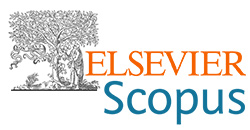Facile Synthesis and adsorptive removal of Rhodamine B dye from aqueous medium using green synthesized nanocomposite
DOI:
https://doi.org/10.62638/ZasMat1201Abstract
Reduced graphene oxide (rGO) and zinc oxide nanoparticles (ZnO NPs) were synthesized using modified Hummer's method and green approach from Carica papaya leaf extract (CPLE), respectively. ZnO NPs were then loaded onto rGO using a straightforward ultrasonic method to synthesize Zinc oxide-reduced graphene oxide nanocomposite (ZnO-rGO NC). Fourier Transform Infrared Spectroscopy (FTIR), Field Emission Scanning Electron Microscopy (FESEM), and X-ray diffraction (XRD) techniques were used to characterize the synthesized nanoparticles and composite respectively. The nanocomposite was used to remove Rhodamine B dye (RhB) from aqueous solution. The effects of temperature, pH, adsorbent dosage, initial dye concentration, and contact time were investigated. Testing was done on the Freundlich and Langmuir isotherm models as well and the thermodynamics parameters were computed. The effects of ZnO NPs, rGO, and ZnO-rGO NC independently on dye removal in a comparative analysis were carried out and resulteds were presented. In an aqueous medium, the nanocomposite demonstrated high removal efficiency as an adsorbent for removing RhB dye at 99% compared to ZnO NPs at 60%. ZnO-rGO NC proved to be an effective adsorbent compare to ZnO NPs.
Keywords:
Adsorption, ZnO nanoparticles, nanocomposites, pollutants, rhodamine b, reduced graphene oxide, carica papayaReferences
López-Rodríguez, D., Micó-Vicent, J., Jordan Nunez, J., Bonet-Aracil, M., & Bou-Belda, E. "Uses of nanoclays and adsorbents for dye recovery: A textile industry review." Applied Sciences 11, no. 11 (2021): 11422. https://doi.org/10.3390/app112311422.
Tu, Y., Shao, G., Zhang, W., Chen, J., Qu, Y., Zhang, F., Tian, S., Zhou, Z., & Ren, Z. "The degradation of printing and dyeing wastewater by manganese-based catalysts." Science of the Total Environment 828 (2022): 154390. https://doi.org/10.1016/j.scitotenv.2022.154390.
Hajipour, N., Ghorbanpour, M., Safajou-Jahankhanemlou, M., & Safajou-Jahankhanemlou, M. "Synthesis and characterization of solid-state Fe-exchanged nano-bentonite and evaluation of methyl orange adsorption." Environmental Science and Pollution Research 29 (2022): 49898–49907. https://doi.org/10.1007/s11356-022-19326-4.
Alsukaibi, A.K.D. "Various approaches for the detoxification of toxic dyes in wastewater." Processes 10, no. 10 (2022): 1968. https://doi.org/10.3390/pr10101968.
Serpone, N., & Emeline, A.V. "Semiconductor photocatalysis—past, present, and future outlook." Journal of Physical Chemistry Letters 3, no. 6 (2012): 673–677. https://doi.org/10.1021/jz300071j.
Di Mauro, A., Fragala`, M.E., Privitera, V.G., & Impellizzeri, G. "ZnO for application in photocatalysis: From thin films to nanostructures." Materials Science in Semiconductor Processing 69 (2017): 44–51. https://doi.org/10.1016/j.mssp.2017.03.029.
Özgür, U., Alivov, I.Y., Liu, C., Teke, A., Reshchikov, M.A., Doğan, S., Avrutin, V., Cho, S.J., & Morkoç, H. "A comprehensive review of ZnO materials and devices." Journal of Applied Physics 98, no. 4 (2005): 041301. https://doi.org/10.1063/1.1992666.
Tian, J., Zhang, Q., Zhang, L., Gao, R., Shen, L., Zhang, S., Qu, X., & Cao, G. "ZnO/TiO2 nanocable structured photo electrodes for CdS/CdSe quantum dot co-sensitized solar cells." Nanoscale 5 (2013): 936–943. https://doi.org/10.4028/www.scientific.net/amr.873.556.
Talam, S., Srivinasa, R.K., & Nagarjuna, G. "Synthesis, characterization, and spectroscopic properties of ZnO nanoparticles." IRSN Nanotechnology 1–6 (2012): 372505. https://doi.org/10.5402/2012/372505.
Nguyen, N.T., & Nguyen, V.A. "Synthesis, characterization, and photocatalytic activity of ZnO nanomaterials prepared by a green, nonchemical route." Journal of Nanomaterials (2020): 1768371. https://doi.org/10.1155/2020/1768371.
Sousa, J.C.G., Ribeiro, A.R., Barbosa, M.O., Pereira, M.F.R., & Silva, A.M.T. "A review on environmental monitoring of water organic pollutants identified by EU guidelines." Journal of Hazardous Materials 344 (2018): 146–162. https://doi.org/10.1016/j.jhazmat.2017.09.058.
Moharm, A.E., Naeem, G.A., Soliman, H.M.A., Abdelhamid, A.I., Elbardan, A.A., Kassem, T.S., Nayl, A.A., & Brase, S. "Fabrication and characterization of effective biochar biosorbent derived from agricultural waste to remove cationic dyes from wastewater." Polymers 14, no. 13 (2022): 2587. https://doi.org/10.3390/polym14132587.
Ferreira, S.H., Morais, M., Nunes, D., Oliveira, M.J., Rovisco, A., & Pimentel, A. "High UV and sunlight photocatalytic performance of porous ZnO nanostructures synthesized by a facile and fast microwave hydrothermal method." Materials 14, no. 9 (2021): 2385. https://doi.org/10.3390/ma14092385.
Luo, D., Wang, L., Nan, H., Cao, Y., Wang, H., Kumar, T.V., & Wang, C. "Phosphorus adsorption by functionalized biochar: A review." Environmental Chemistry Letters 21 (2022): 497–524. https://doi.org/10.1007/s10311-022-01519-5.
Zhao, F., Shan, R., Gu, J., Zhang, Y., Yuan, H., & Chen, Y. "Magnetically recyclable loofah biochar by KMnO4 modification for adsorption of Cu(II) from aqueous solutions." ACS Omega 7, no. 8 (2022): 8844–8853. https://doi.org/10.1021/acsomega.1c07163.
Premarathna, K.S.D., Rajapaksha, A.U., Adassoriya, N., Sarkar, B., Sirimuthu, N.M., Cooray, A., Ok, Y.S., & Vithanage, M. "Clay-biochar composites for sorptive removal of tetracycline antibiotic in aqueous media." Journal of Environmental Management 238 (2019): 315–322. https://doi.org/10.1016/j.jenvman.2019.02.069.
Jaiswal, P., Kumar, P., Singh, V.K., & Singh, D.K. "Carica papaya Linn: A potential source for various health problems." Journal of Pharmacy Research 3, no. 5 (2010): 998–1003.
Koupaei, M.H., Shareghi, B., Saboury, A.A., Davar, F., Semnani, A., & Evini, M. "Green synthesis of zinc oxide nanoparticles and their effect on the stability and activity of proteinase K." RSC Advances 6, no. 48 (2016): 42313–42323. https://doi.org/10.1039/C5RA24862K.
Kumar, B., Smita, K., Cumbal, L., & Debut, A. "Green approach for fabrication and applications of zinc oxide nanoparticles." Bioinorganic Chemistry and Applications (2014): 523869. https://doi.org/10.1155/2014/523869.
Qu, J., Yuan, X., Wang, X., & Shao, P. "Zinc accumulation and synthesis of ZnO nanoparticles using Physalis alkekengi L." Environmental Pollution 159, no. 7 (2011): 1783–1788. https://doi.org/10.1016/j.envpol.2011.04.016.
Qu, J., Luo, C., & Hou, J. "Synthesis of ZnO nanoparticles from Zn-hyper accumulator (Sedum alfredii Hance) plants." Micro & Nano Letters 6, no. 3 (2011): 174–176. https://doi.org/10.1049/mnl.2011.0004.
Lee, H.J., Lee, G., Jang, N.R., Yun, J.H., Song, J.Y., & Kim, B.S. "Biological synthesis of copper nanoparticles using plant extract." Nanotechnology 1, no. 1 (2011): 371–374. https://doi.org/10.3390/polym13244364.
Lee, H.U., Ahn, K., Lee, S.J., Kim, J.P., Kim, H.G., Jeong, S.Y., & Cho, C.R. "ZnO Nano barbed fibers: fabrication, sensing NO2 gas, and their sensing mechanism." Applied Physics Letters 98, no. 19 (2011): 19301. https://doi.org/10.1063/1.3590202.
Salam, H.A., Sivaraj, R., & Venckatesh, R. "Green synthesis and characterization of zinc oxide nanoparticles from Ocimum basilicum L. var. purpurascens Benth.-Lamiaceae leaf extract." Materials Letters 131 (2014): 16–18. https://doi.org/10.1016/j.matlet.2014.05.033.
Agarwal, A.H., Kumar, S.V., & Rajeshkumar, S. "A review on green synthesis of zinc oxide nanoparticles–An eco-friendly approach." Resource-Efficient Technologies 3, no. 4 (2017): 406–413. https://doi.org/10.1016/j.reffit.2017.03.002.
Love, A.J., Makarov, V.V., Sinitsyna, O.V., Shaw, J., Yaminsky, I.V., Kalinina, N.O., & Taliansky, M.E. "A genetically modified tobacco mosaic virus that can produce gold nanoparticles from a metal salt precursor." Frontiers in Plant Science 6 (2015): 984. https://doi.org/10.3389/fpls.2015.00984.
Happy, A., Soumya, M., Kumar, S.V., Rajeshkumar, S., Rani, N.D.S., Lakshmi, T., & Nallaswamy, V.D. "Phyto-assisted synthesis of zinc oxide nanoparticles using Cassia alata and its antibacterial activity against Escherichia coli." Biochemical and Biophysical Research Communications (2019): 01002. https://doi.org/10.1016/j.bbrep.2019.01.002.
Suresh, J., Pradheesh, G., Alexramani, V., Sundrarajan, M., & Hong, S.I. "Green synthesis and characterization of zinc oxide nanoparticle using insulin plant (Costus pictus D. Don) and investigation of its antimicrobial as well as anticancer activities." Advanced Natural Sciences (2018): aaa6f1. https://doi.org/10.1088/2043-6254/aaa6f1.
Li, B.J., & Cao, H.Q. "ZnO @graphene composite with enhanced performance for the removal of dye from water." Journal of Materials Chemistry 21 (2011): 3346–3349. https://doi.org/10.1039/C0JM03253K.
Jayachandiran, J., Yesuraj, J., Arivanandhan, M., Raja, A., Suthanthiraraj, S.A., Jayavel, R., & Nedumaran, D.J.J.O.I. "Synthesis and electrochemical studies of rGO/ZnO nanocomposite for supercapacitor application." Journal of Inorganic and Organometallic Polymers and Materials 28, no. 4 (2018): 2046–2055. https://doi.org/10.1007/s10904-018-0873-0.
Khatoon, N., Khan, A.H., Pathak, V., & Agnihotri, A.H. "Removal of hexavalent chromium from synthetic wastewater using synthetic nano zero valent iron (NZVI) as adsorbent." International Journal of Innovative Research in Science, Engineering and Technology 2, no. 11 (2013): 6140–6149.
Dulta, K., Koşarsoy Ağçeli, G., Chauhan, P., Jasrotia, R., & Chauhan, P.K. "Ecofriendly synthesis of zinc oxide nanoparticles by Carica papaya leaf extract and their applications." Journal of Cluster Science 32 (2021): 1–15. https://doi.org/10.1007/s10876-020-01962-w.
Kaliraj, L., Ahn, J.C., Rupa, R.J., Abid, S., Lu, J., & Yang, D.C. "Synthesis of panos extract mediated ZnO nano-flowers as photocatalyst for industrial dye degradation by UV illumination." Journal of Photochemistry and Photobiology B: Biology 199 (2019): 111588. https://doi.org/10.1016/j.jphotobiol.2019.111588.
Davis, K., Yarbrough, R., Froeschle, M., White, J., & Rathnayake, H. "Band gap engineered zinc oxide nanostructures: Via a sol-gel synthesis of solvent driven shape-controlled crystal growth." RSC Advances 9, no. 26 (2019): 14638–14648. https://doi.org/10.1039/C9RA02091H.
Aysan, H., Edebali, S., Ozdemir, C., Karakaya, M.C., & Karakaya, N. "Use of chabazite, a naturally abundant zeolite, for the investigation of the adsorption kinetics and mechanism of methylene blue dye." Microporous and Mesoporous Materials 235 (2016): 78–86. https://doi.org/10.1016/j.micromeso.2016.08.007.
Zhang, X., Cheng, C., Zhao, J., Ma, L., Sun, S., & Zhao, C. "Polyethersulfone enwrapped graphene oxide porous particles for water treatment." Chemical Engineering Journal 215–216 (2013): 72–81. https://doi.org/10.1016/j.cej.2012.11.009.
Kamaraj, R., & Vasudevan, S. "Evaluation of electrocoagulation process for the removal of strontium and cesium from aqueous solution." Chemical Engineering Research and Design 93 (2015): 522–530. https://doi.org/10.1016/j.cherd.2014.03.021.
Kamaraj, R., Ganesan, P., & Vasudevan, S. "Removal of lead from aqueous solutions by electrocoagulation: isotherm, kinetics and thermodynamic studies." International Journal of Environmental Science and Technology 12 (2015): 683–692. https://doi.org/10.1007/s13762-013-0457-z.
Vasudevan, S., Lakshmi, J., & Sozhan, G. "Optimization of electrocoagulation process for the simultaneous removal of mercury, lead, and nickel from contaminated water." Environmental Science and Pollution Research 19 (2012): 2734–2744. https://doi.org/10.1007/s11356-012-0773-8.
Vasudevan, S., Lakshmi, J., & Sozhan, G. "Simultaneous removal of Co, Cu, and Cr from water by electrocoagulation." Toxicological and Environmental Chemistry 94, no. 10 (2012): 1930–1940. https://doi.org/10.1080/02772248.2012.742898.
Igwe, J.C., & Abia, A.A. "Abioseparation process for removing heavy metals from wastewater using biosorbents." African Journal of Biotechnology 5 (2006): 1167–1179.
Langmuir, I. "The adsorption of gases on plane surfaces of glass, mica and platinum." Journal of the American Chemical Society 40, no. 9 (1918): 1361–1403. https://doi.org/10.1021/ja02242a004.
Vasudevan, S., Lakshmi, J., & Packiyam, M. "Electrocoagulation studies on removal of cadmium using magnesium electrode." Journal of Applied Electrochemistry 40 (2010): 2023–2032. https://doi.org/10.1007/s10800-010-0182-y.
Vasudevan, S., Sozhan, G., Ravichandran, S., Jayaraj, J., Lakshmi, J., & Sheela, S.M. "Studies on the removal of phosphate from drinking water by electrocoagulation process." Industrial & Engineering Chemistry Research 47 (2018): 2018–2023. https://doi.org/10.1021/ie0714652.
Vasudevan, S., Lakshmi, J., & Sozhan, G. "Effects of alternating and direct current in electrocoagulation process on the removal of cadmium from water." Journal of Hazardous Materials 192 (2011): 26–34. https://doi.org/10.1016/j.jhazmat.2011.04.081.







